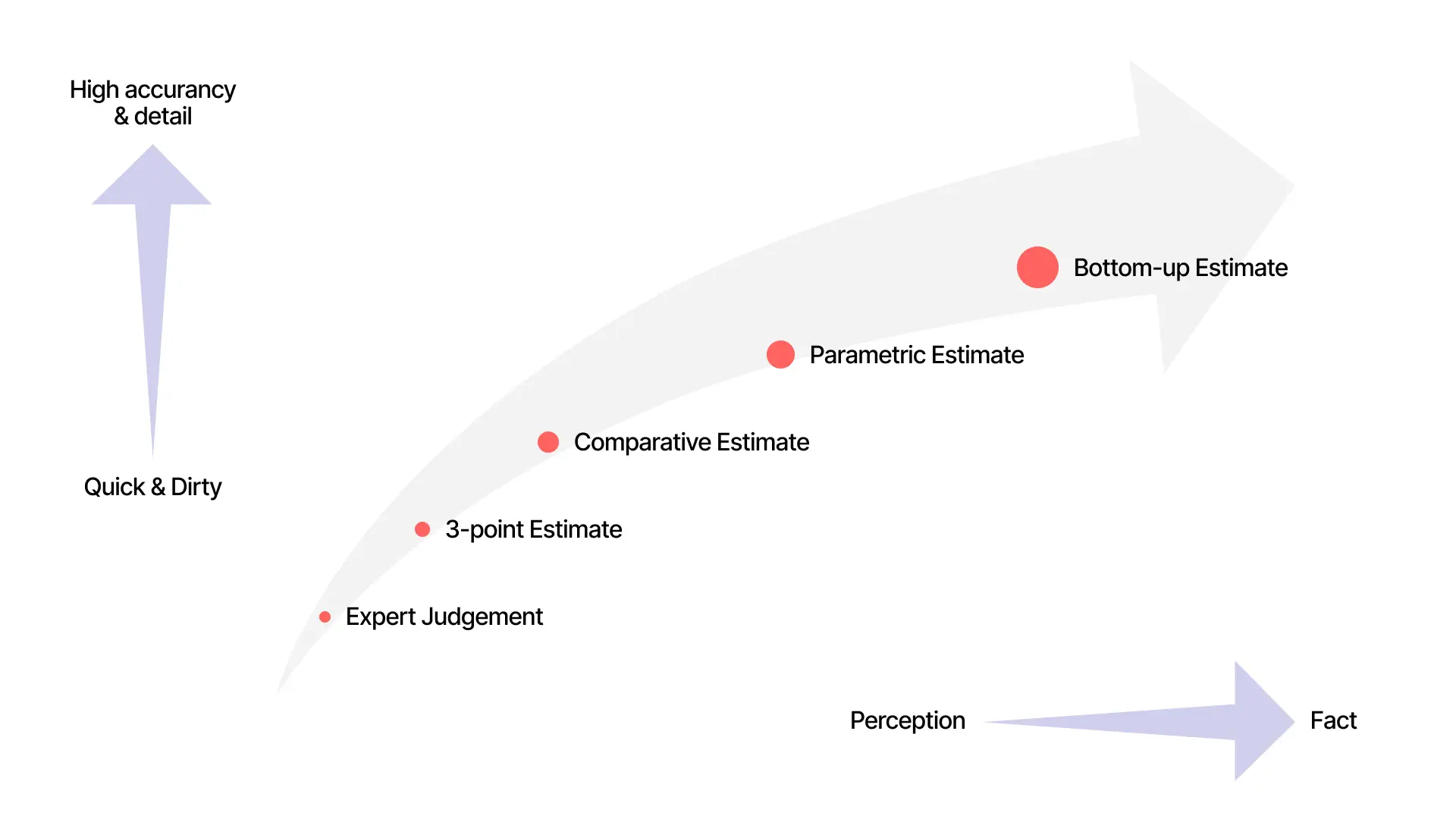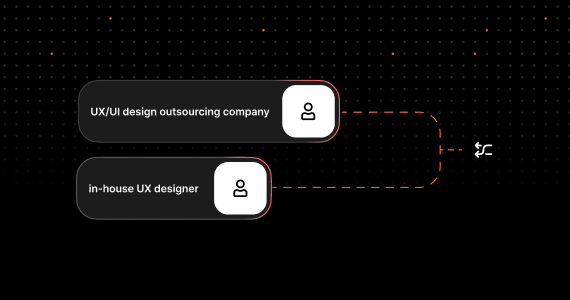Project Estimation: a comprehensive guide to getting it right
Do you know the importance of proper estimation in building a successful project? Whether it’s developing software, building a website, or any other project, accurately estimating the time and cost is crucial for keeping your project on schedule and delivering value.
Good project estimation can help you avoid costly mistakes and delays. We can provide you with a guide that explains how to do project estimation, outlining the process involved and discussing the common challenges you may encounter.
What is project estimation?
Let’s start with the fundamentals of software development estimation, so we can later delve into more detailed and rough estimates.
Project estimation is the process used to calculate and forecast the costs, resources, time, and other factors required for the successful completion of a project. In simpler terms, it is a way for experts to determine the amount of effort and expenses a particular project will require in order to give shape to an idea that was once conceived.
Businesses and enterprises need to grasp the concept of project estimation in order to effectively manage projects and ensure their completion within budget, on schedule, and with expected outcomes.
Why is cost estimation important for a project? Its benefits for your project
With proper project estimation, organizations can ensure they have sufficient resources to complete their projects on time and within budget. By incorporating accurate project estimation into your organization’s workflow, you can experience these benefits and ensure successful project execution. Here are a few reasons why cost estimation is vital for any project:
- Enhanced stakeholder communication. Accurate project estimates provide a solid foundation for effective communication with stakeholders. When everyone involved has a clear understanding of timelines, costs, and deliverables, it becomes easier to manage expectations and address any concerns or questions that may arise.
- Better risk management. Accurate estimations enable teams to identify and assess potential risks early on. This allows for the implementation of proactive risk mitigation strategies, reducing the likelihood of costly setbacks or failures.
- Budget planning. A well-defined cost estimation allows project managers to set a realistic budget and allocate resources accordingly. It helps prevent overspending and ensures that funds are allocated appropriately throughout the project lifecycle.
- Continuous improvement. Accurate estimations provide valuable data for evaluating project performance and identifying areas for improvement. By analyzing the variances between estimated and actual results, organizations can make necessary adjustments to their processes, leading to continuous improvement and increased efficiency.
We can see that cost estimation is essential for project success as it enables effective budget planning, informed decision-making, transparent stakeholder communication, and proactive risk management.
Project estimation techniques
There are several commonly used project estimation techniques that dedicated development teams rely on to assist project managers in making informed decisions. These techniques are instrumental in gaining a comprehensive understanding of a project’s scope and complexity, as well as identifying potential risks that could impact timelines and budgets. The most prevalent types of estimation techniques include:
- Expert judgment. In this technique, project managers seek input and insights from subject-matter experts, experienced team members, or industry professionals who have relevant knowledge and expertise. This approach helps to incorporate valuable insights and considerations that may not be captured by other estimation techniques.
- Three-point estimation. This technique takes into account three separate estimates for each task or activity: the optimistic estimate, the most likely estimate, and the pessimistic estimate. By calculating the weighted average of these three estimates, project managers can arrive at a more realistic and accurate estimate.
- Comparative estimation. In this technique, project managers or estimators analyze historical data from similar projects and identify key variables that have a significant impact on project outcomes. These variables could be factors such as project size, complexity, resources required, or duration.
- Parametric estimation. This technique involves using data from similar past projects to estimate the effort, duration, and cost of the current project. It is typically used when there is limited information available or when the project is similar in nature to previous ones.
- Bottom-up estimation. This technique involves breaking down the project into smaller, more manageable tasks or work packages and estimating the effort, duration, and cost of each individual component. These estimates are then aggregated to provide an overall estimation for the entire project.
By utilizing these estimation techniques, project managers can make more informed decisions, effectively allocate resources, and improve the overall success rate of their projects.
Step-by-step project estimation process
Steve McConnell said it very accurately: “The main goal of software estimation is not to provide the project outcome. It is to determine if the project goals are realistic enough to manage the project towards their achievement.”
That’s why you can hire software developers, but you need to make sure first that you are making a reasonable assessment of your project’s needs. Let’s consider a step-by-step project estimation process:
- Gathering requirements. It’s crucial in understanding what, how, and when the customer wants something. It involves communicating with the customer to gather information about their needs and expectations. This could be done through interviews, surveys, or meetings. By actively listening and asking clarifying questions, project teams can gain a clear understanding of the customer’s requirements and define the project goals and objectives accordingly. Effective requirement gathering ensures that the project aligns with the customer’s vision and enhances the chances of delivering a successful outcome.
- Software decomposition. Based on the information received from the client, conducted research, and analysis, the specialist will need to break down your software into smaller components and functions, and then classify them according to a specific set of components. This step can be compared to the structure of work breakdown, but only for software components. The client can also receive additional information from the project team during this process.
- Component estimate size. At this step, each component in software project management will receive its individual assessment. Here, it is possible to study different evaluation results using analytical approaches. It is also possible to combine these assessments using the average value.
- Reviews and feedback. The project estimation process is iterative and dynamic, meaning that estimates may need to be adjusted as more information becomes available or as project circumstances change. To make sure the choice is right, you can use certain strategies for similar analogues of earlier projects.
- Completion of assessment. Having the initial assessment of all components and functions, you can repeat the procedure until you obtain an accurate estimate that is approved by management and the project team. The above steps have provided a general outline of how software outsourcing providers perform software estimation at the beginning of the development process. It is during this stage that the team is formed to bring your project to life.
The costs of hiring developers, UI/UX designers, and other team members are determined and depend on the project’s complexity and the time required for its development.
Estimating projects is a necessary part of project management. An effective estimation process can help ensure that your team has realistic expectations for what can be accomplished and when it should be completed.
Software estimation process by Solar Digital company
Our professional software development Solar Digital company can provide valuable insight into the complexities of a project and estimate how much time, money, and resources will be needed to complete it. We know how to account for dependencies, risks, and other factors that may influence the outcome of a project.
In our company, the evaluation of software projects is done as follows:
Rough estimation
After receiving project information from you, we break down all the work into functions and evaluate each of them, resulting in an approximate estimation. Taking into account the project details and potential risks, the accuracy of the estimation is usually up to 75 %. To increase the accuracy of the estimation, additional steps need to be taken:
- Firstly, we set goals, determine the main scope of tasks, level of complexity, constraints, possible risks, and their mitigation. We evaluate everything and propose a price based on the provided information.
- Secondly, we study the specifics of business processes, key development criteria, non-functional requirements, and architectural solutions. At this stage, a more specific approximate estimation is created, which improves the accuracy of all requirements and the composition of the project team.
Detailed estimation
This estimate is the most accurate in project management. Developers actively involved in product creation participate in this iterative process. In this process, a business analyst creates user stories for each sprint in advance. When compiling this estimation, our company takes into account steps such as:
- Rough order of magnitude. This type of estimate is done in the early stages of a project when the details are limited. It provides a broad estimation of the project’s cost based on historical data or expert judgment. The accuracy of this estimate is relatively low, usually within a range of +/- 50 %.
- Preliminary estimate. As the project progresses and more information becomes available, a preliminary estimate is prepared. It takes into account the project’s scope, requirements, and initial design. Though still not precise, this estimate narrows down the cost range to around +/- 35 %. It helps in making initial budget allocations and getting stakeholders' approval.
- Budget estimate. Once the project’s scope and design are well-defined, a budget estimate is created. It considers the detailed breakdown of work, resources required, and their associated costs. This estimate has a higher level of accuracy, typically within a range of +/- 20 %. It forms the basis for project funding, resource allocation, and cost control.
- Definitive estimate. As the project progresses further, a definitive estimate is developed. It includes precise cost calculations based on detailed specifications, quantities, and resource rates. This estimate is highly accurate, usually within a range of +/- 10 %. It helps in making critical decisions, negotiating contracts, and ensuring project profitability.
- Final estimate. Towards the end of the project, a final estimate is prepared to capture any remaining changes or updates. It takes into account the actual costs incurred, adjustments made, and any unforeseen circumstances. This estimate provides the most accurate representation of the project’s total cost.
Conclusion
Different types of estimates serve different purposes in project management. From rough estimates in the early stages to final estimates at project completion, these estimates help in budgeting, decision-making, and overall cost control.
You can use this article for independent work on estimation of your project, or you can turn to specialists who will help you save time and resources.
By following this comprehensive software estimation process, Solar Digital aims to provide accurate and reliable estimates to its clients, enabling successful project planning and execution.
Since 2016, we have successfully completed more than 135 projects for such business areas as:
- software for media platforms.
- software for logistics.
- platforms and software for travel and hospitality.
All these projects are successful and fully meet the initial requirements and expectations, starting from a thorough and accurate project assessment. To partner with us, you are one step ahead of your competitors!




